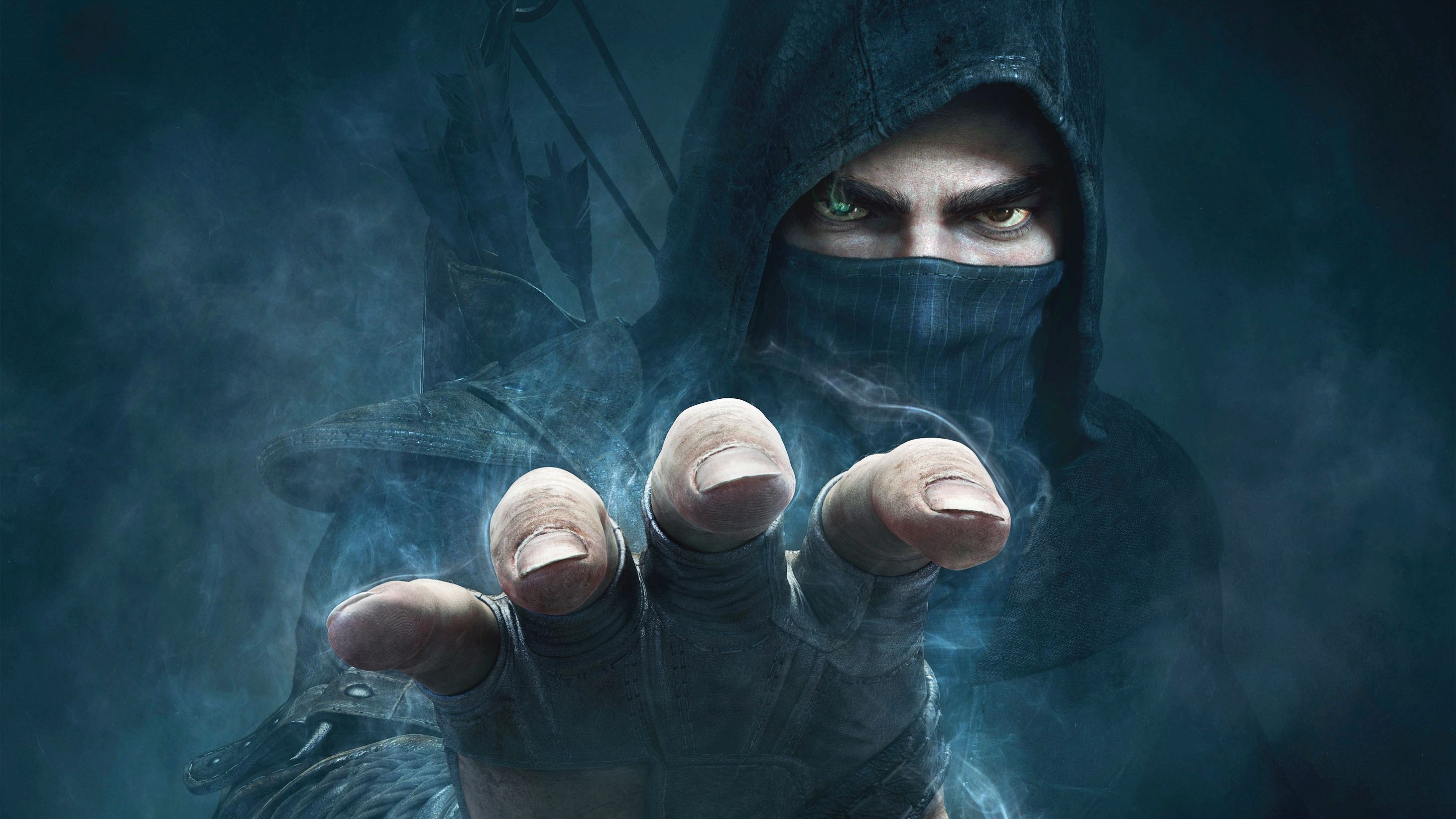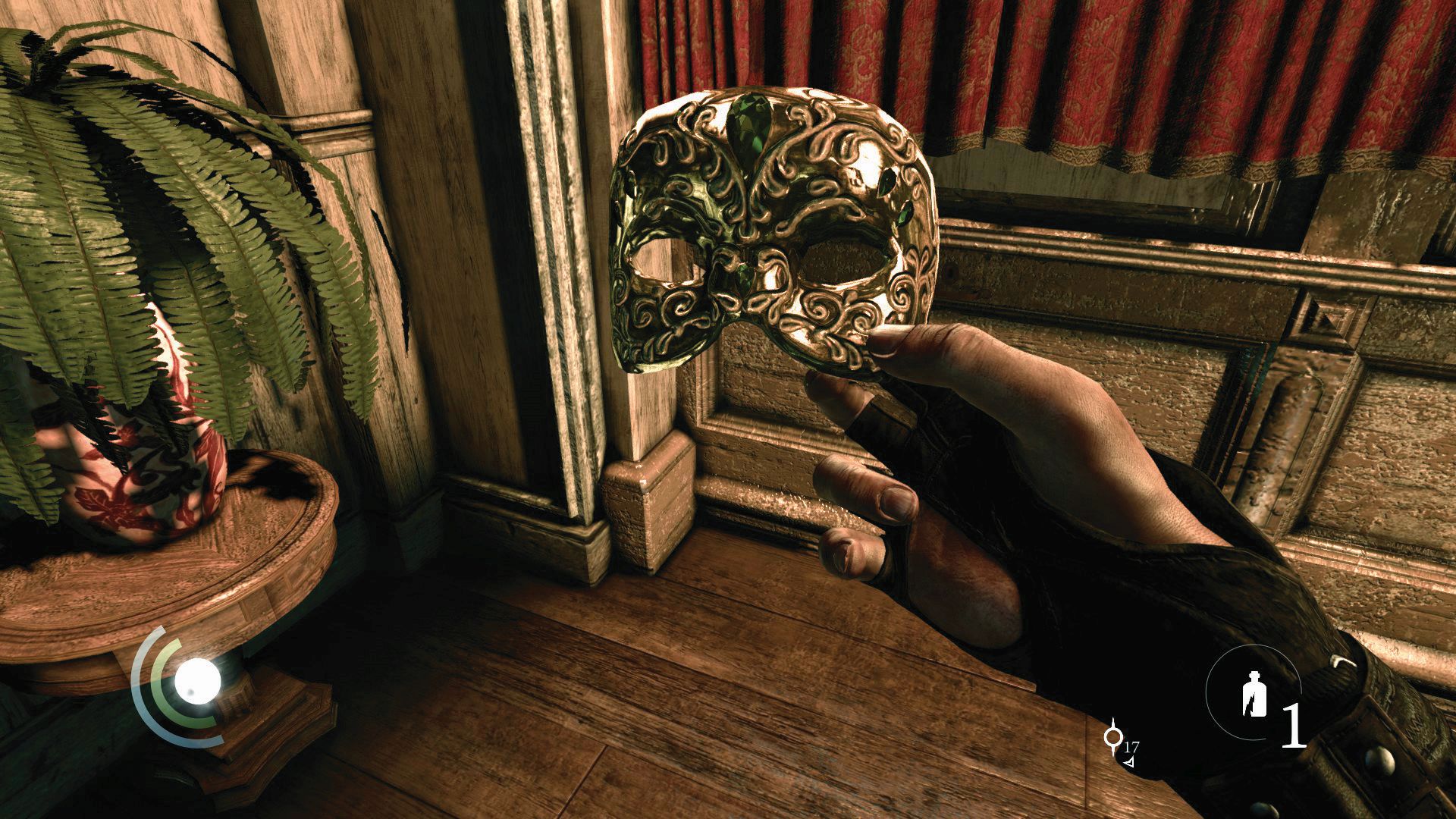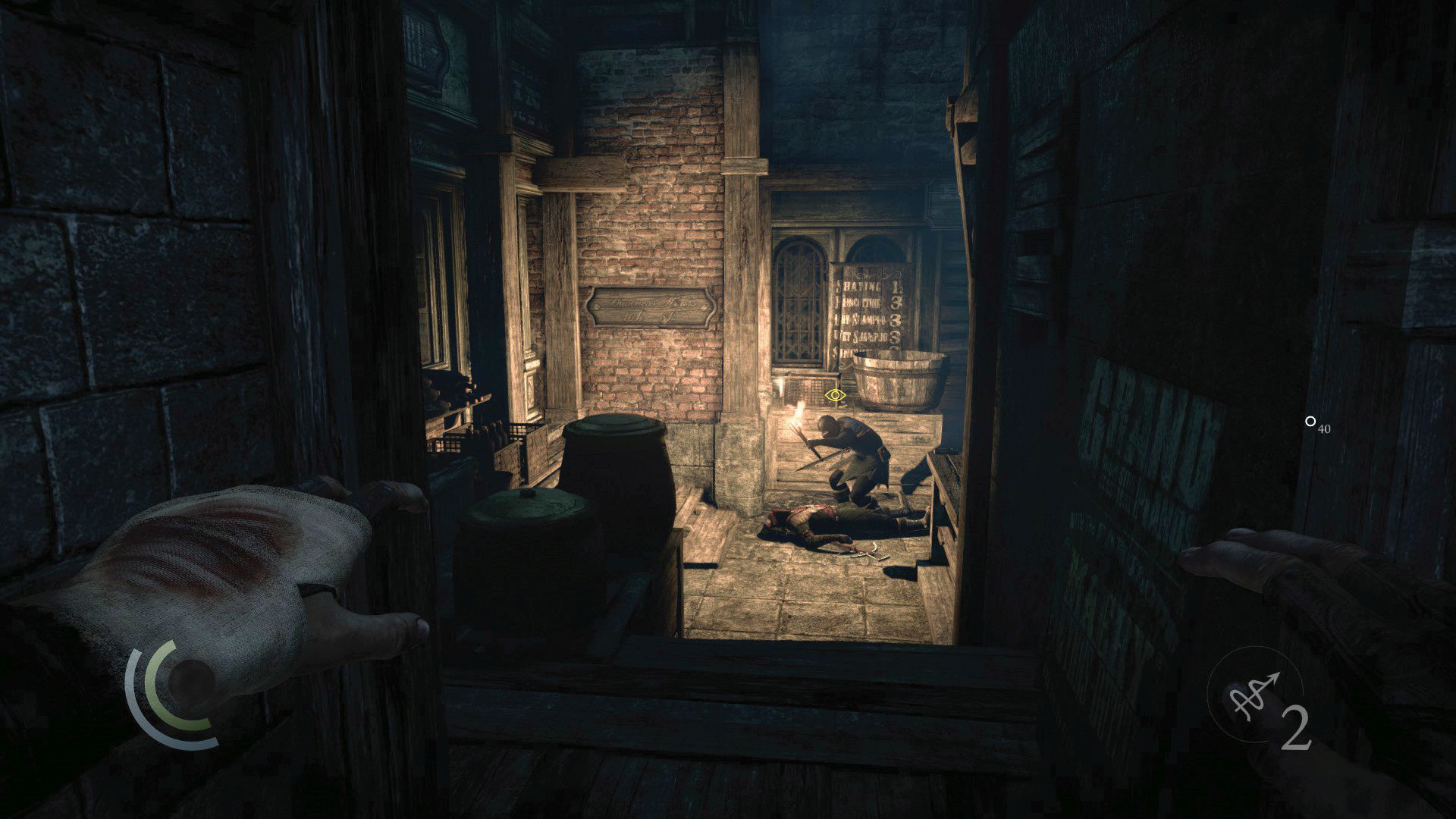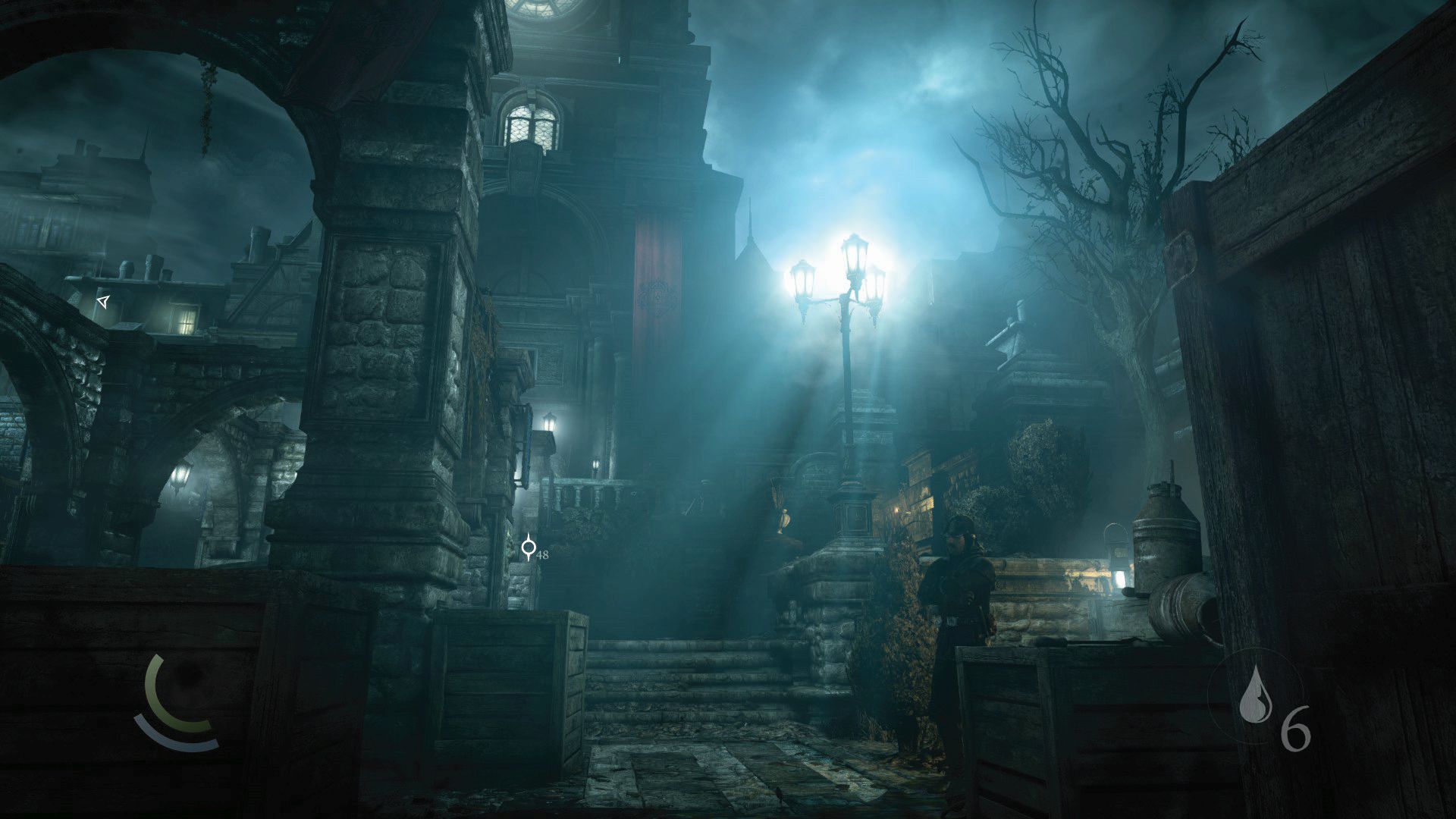

Reinstall invites you to join us in revisiting PC gaming days gone by. Today, Rick Lane finds the positives in the troubled Thief reboot.
Thief: The Dark Project was a game obsessed with feet. Its protagonist, Garrett, seemed to enjoy making life difficult for himself by wearing clogs on any job he undertook. His wooden-soled shoes would scuff stone cobbles, crunch on grass, click loudly on tile floors, and clang like church bells on metal walkways. To avoid detection and successfully infiltrate a building, players had to listen intently to both their own footsteps and those of the city watch. It was even possible to interpret a guard’s alertness, whether they’re patrolling, searching, or chasing after you purely by the rhythm of their movements.
By comparison, Eidos Montreal’s reboot of Thief doesn’t care much for feet, but it certainly has a thing for hands. The rebooted Garrett sports a lovely pair of mitts. Whether it involves swiping a cup off a tabletop, daintily picking the lock of a safe, or caressing the edges of a picture frame in search of a switch, almost every manual interaction in the game is beautifully animated. You can even see the chips in Garrett’s fingernails.
Many would argue this switch of emphasis marks the point at which the reboot starts to go wrong, a misguided emphasis on what looks and feels good, as opposed to what’s important for quality stealth. There’s some truth in that, but as an advocate of tactility in games, I can’t help but love the attention to detail directed at touching stuff. I’ve plundered every corner of grimy, topsy-turvy Dayport twice over, solving every riddle and raiding every smuggler’s stash, all because I love rummaging through its virtual drawers and cupboards.
Stealing hearts
As I’ve done so, I’ve come to admire what Thief gets right, rather than bemoan what it gets wrong. Like the previous game in the series, 2004’s Deadly Shadows, Thief attempts to expand its stealthy play into an open world scenario. In many ways it’s a similarly compromised vision, but Eidos Montreal is far more successful in presenting us with a metropolis ripe for plundering. Dayport comprises two main districts, each of which is made up of two or three separate areas, alongside a bunch of specialised locales reserved for main quests and sidequests.
These districts are towering mazes of cobbled streets and muddy alleys, rain-slick rooftops and wooden walkways. They’re also gloomily gorgeous. The city’s endless night is painted in a thousand shades of black, conveying a moonlit darkness without leaving the player blind. I love the canal area of South Quarter, where apartments are stacked three or four storeys high, teetering over waterways that run deep beneath the streets, connected by crisscrossing boardwalks that resemble a halffinished game of Jenga.
Crossing the city efficiently is a challenge in and of itself. When you start the game, the Thieves’ Highway is only half-constructed, and you fill in the gaps by lowering ladders and gantries, and shooting rope arrows in the appropriate places. In some ways it’s more restrictive than the earlier games—disappointingly, the rope arrows which used to attach to any wood surface now only latch onto designated ones. But in others the freedom to scoot over rooftops and use people’s homes as a thoroughfare is hugely liberating, like Thief II’s Life of the Party writ large.

The real joy of exploring Dayport, however, is in shops and apartments ripe for pilfering as you pass from mission to mission. Some of these involve little more than simple burglary. Hop through the window, grab everything that glints, exit through the grift shop: job done. But in what is by far the game’s best design decision, many require you to solve a little puzzle.
The biggest gaming news, reviews and hardware deals
Keep up to date with the most important stories and the best deals, as picked by the PC Gamer team.
The House of Blossoms and Eastwick’s Grand House, allow a level of creative approach, but Thief only features one mission—Baron Northcrest’s manor—that truly embodies the design philosophy of those older games.
These come in countless different forms, such as pressing a switch behind a bed to reveal a false wall, or disabling a series of traps by following a wire to a nearby junction box. The best ones revolve around spatial puzzling, such as a basement visible through a window at street level, but with no obvious point of entry, or figuring out how to access a lofty rooftop flat. Deciphering these often elaborate teasers is my favourite part of Eidos Montreal’s vision.
This design works fantastically for the game’s smaller-scale distraction. But Eidos also applies it to the game’s larger story missions, and this is where problems arise. The first proper mission, which sees Garrett searching for a ring in an ironworks, hooks you onto a rail for much of its duration. Indeed, the levels are far more linear than those designed by either Looking Glass or Ion Storm.
A few, such as the House of Blossoms and Eastwick’s Grand House, allow a level of creative approach, but Thief only features one mission—Baron Northcrest’s manor—that truly embodies the design philosophy of those older games. Even this is bookended by linear sequences, including an explosive finale that is as far removed from the Looking Glass games as possible.
Writ large
There are other problems, too. The story is terrible and full of onedimensional characters. It revolves around Garrett’s search for his protégé Erin, who goes missing after they interrupt an occult ritual at Northcrest’s manor during the intro. But Erin is far too brattish and annoying to incur much sympathy.
By far the weakest character, however, is the antagonist, the Thief-Taker General. The game is keen for you to understand just how evil he is, showing you how he kills his subordinates and beats prostitutes for little reason. It couldn’t be less subtle. Mercifully, aside from some questionable costume design, Garrett survives largely intact, although the game’s awkward attempt to paint him as a reluctant hero is summed up in the clanging line, “To be alone, you need something to be alone from.”
The actual stealth play is enjoyable enough. I particularly like the ‘Swoop’ system, which lets Garrett glide several paces in any direction while minimising detection. But the fundamental act of sneaking past guards is sometimes lost in the game’s haphazard attempt to blend an open city with linear setpieces. There are several levels in which stealth is barely required at all, including the Moira Asylum—a knockoff of the Shalebridge Cradle that has a few good scares but lacks the layered dread baked into Deadly Shadows’ standout mission.

Even the game’s strongest feature, the city itself, is a flawed gem. There’s a sense that it is unfinished, hinted at by the minimal number of Basso jobs—sidequests you pick up from your fence—in the second half of the game. Most of these reuse areas that you’ve explored, indicating they were added in to pad the game out.
Small change
Other clues can be found in the Clients, NPCs who provide you with more elaborate missions that take place in specialised locations. But there are only two clients—Ector and Vittori—each of whom offers three missions each, a small number for such a large map. Finally, the way the different zones are stitched together feels roughshod. There’s a whole area of the city—Grandmauden—that you can easily miss until the game directs you straight to it in its closing stages.
In a weird way, the city’s muddled layout feels somewhat appropriate. I like the fact that to move between districts, you often have to clamber through a window or squeeze into a tunnel filled with crates, rather than simply walking through a gate. It adds to the organic feel of Dayport’s Gothic sprawl, conveying the idea that Garrett treads a path unique to him. Meanwhile, that thrill of choosing which building to break into has an appeal that I believe transcends the game’s flaws. Thief may not be a great Thief game, but it is a decent burglary sim and, while it may not achieve the lofty heights of its predecessors, I believe it.
Rick has been fascinated by PC gaming since he was seven years old, when he used to sneak into his dad's home office for covert sessions of Doom. He grew up on a diet of similarly unsuitable games, with favourites including Quake, Thief, Half-Life and Deus Ex. Between 2013 and 2022, Rick was games editor of Custom PC magazine and associated website bit-tech.net. But he's always kept one foot in freelance games journalism, writing for publications like Edge, Eurogamer, the Guardian and, naturally, PC Gamer. While he'll play anything that can be controlled with a keyboard and mouse, he has a particular passion for first-person shooters and immersive sims.

